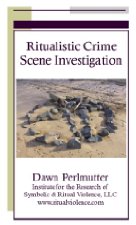Another in an occasional series about books that disorient, perplex, or cause us to question our decision-making abilities. Today, we look at poorly produced literature for police on what to do when battling satanists.
Ritualistic Crime Scene Investigation, by Dawn Perlmutter. The Institute for the Research of Symbolic & Ritual Violence, LLC (Pennsylvania, 2007).
The professional literature intended for law enforcement audiences is a subject of enduring fascination for me. Police departments around the country contain small libraries of books on how to pass sergeants’ exams, community outreach strategies, Spanish for police officers, and field guides to gang graffiti. Like college chemistry textbooks and fetish porn, though, these books are intended for small, specialist audiences, and therefore carry hefty price tags, largely keeping them away from the general public.
The volume under consideration is intended as a guide for police officers confronting crimes committed by members of little-understood religious and cultural groups, ranging from followers of Santeria to teenage satanists. This kind of thing is actually very helpful in theory: a police officer responding to a call who finds a yard full of people in white standing around a goat whose throat is about to be cut might not understand that they are carrying out ceremonies explicitly included under the First Amendment’s protection of religious practice. As more people emigrate to the U.S. from countries where belief in magic and witchcraft are robust, this will become a larger issue: I have Google alerts that tell me animal mutilations and spell-castings are a daily affair in much of the country.
That said, I hate to think of any police officers investigating crimes with this handbook as a guide. Little more than a pamphlet, it has context-free sections on various religious groups that are notable for being devoid of things police officers might want to know: who practices Palo Mayombe? How many of them are there? Where do they live?
This reads like a high school report grudgingly padded out with arbitrarily-selected information designed to meet a page count. Full 15 of its 54 pages are lists of symbols supposedly common in ritualistic crime, but it’s hard to imagine how often most cops will encounter “the inverted cross of Satanic justice,” let alone the “Cimaruta.”
It’s rounded out by some truly grisly crime scene photos, along with a tip sheet on how to conduct an occult-related investigation. The latter is promising in theory, until you read such tips as “Document all evidence as soon as it is received,” and “Execute search warrants as soon as needed, but not short of probable cause.” This is a little like saying your top secret strategy for winning the Super Bowl is to have some players carry the ball and others catch passes until one of them gets to the end zone.
A corrections officer of my acquaintance who’s shown me his personally-compiled book of gang tattoos has pointed me in the direction of what he says is a much better occult crime investigation guide, but it’s $75 (there’s that textbook pricing strategy for you). I’m thinking about it, but in the meantime, if I ever start a teenage death metal band, this guide at least provides a wealth of potential logos.
(V. Charm)

